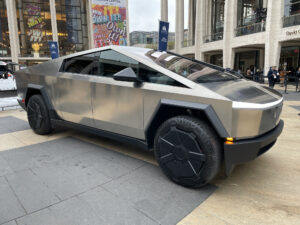
Safety professionals weigh in on Tesla’s Cybertruck
By onAnnouncements
Safety concerns related to Tesla’s Cybertruck have arisen, with some industry members saying that the vehicle’s angular design and stainless steel body could pose danger to other road users.
A Reuters report released last week included interviews with six safety professionals who shared opinions on whether the truck, which entered production this month, would cause excessive damage or harm to others in the event of a collision.
“The big problem there is if they really make the skin of the vehicle very stiff by using thick stainless steel, then when people hit their heads on it, it’s going to cause more damage to them,” Adrian Lund, former Insurance Institute for Highway Safety (IIHS) president, told the outlet.
However, an IIHS spokesman told Repairer Driven News that such worries could be premature.
“IIHS hasn’t evaluated the Cybertruck,” Russ Radar said. “The discussions we’ve seen so far appear to be based on speculation.
“I would add that our experience with Tesla is that they aim for the highest safety ratings in IIHS tests. We have no reason to expect anything different with the Cybertruck.”
Radar noted that all vehicle-to-pedestrian collisions can be deadly or cause serious injuries and that the risks are greater when speed is involved.
It’s also worth noting that the IIHS said last month that vehicles with tall front ends are more deadly during pedestrian-involved collisions when compared with vehicles with shorter hoods.
IIHS data indicates that pickups, SUVs, and vans with hood heights greater than 40 inches and grilles sloped at an angle of 65 degrees are 45% more likely to cause a pedestrian fatality during a crash. It said it came to that conclusion after studying nearly 18,000 pedestrian crashes.
“For medium height vehicles, blocky or blunt shaped front-ends also increase risk,” Radar said. “We haven’t had an opportunity to measure the front end of the Cybertruck, so we don’t know how it compares to other pickups or SUVs.”
Also quoted in the Reuters article was David Friedman, former acting head of the National Highway Traffic Safety Administration (NHTSA). He said in a collision involving a Cybertruck and another passenger vehicle, the latter could emerge as victims.
“If you’re in a crash with another vehicle that has a crumple zone and your car is more stiff, then their cars are going to crush and yours is resistant,” Friedman said.
A NHTSA spokesperson did not comment on whether it had concerns about the Cybertruck’s design, saying: “NHTSA does not ‘approve’ new vehicles. NHTSA establishes performance requirements in Federal Motor Vehicle Safety Standards and manufacturers certify compliance with FMVSS requirements.”
NHTSA added that it has not crash-tested the vehicle. The Cybertruck is not included in a list of model year 2024 vehicles NHTSA plans to test next year under its five-star safety ratings program.
Concerns arose about the Cybertruck after a Tesla video was shared on YouTube, demonstrating how the cabin remained virtually unscathed in a full frontal overlap test. There are no signs of a crumple zone.
Samer Hamdar, a George Washington University auto safety professor, told Reuters that while a lack of crumple zones concerned him, there could be other factors that accounted for it.
“There might be a possibility of shock-absorbent mechanism that will limit the fact that you have a limited crumple zone,” Hamdar said.
Meanwhile, the Center for Automotive Safety took to Elon Musk-owned X, formerly known as Twitter, to critique the vehicle’s design.
“At over 6k lbs no one will ever doubt your manhood again,” the center wrote in a message, seemingly directed at Musk. “We get it. You were picked last in gym and now you want revenge. But this isn’t the answer. Buying this is why you were picked last. It’s desperate and dangerous to everyone else on the road. Stop being picked last.”
Michael Brooks, the Center for Auto Safety’s executive director, told Repairer Driven News that the Cybertruck poses numerous possible threats to pedestrians.
To mitigate safety concerns related to the Cybertruck, he said that, in the absence of a U.S. standard for pedestrian crashworthiness, Tesla could design the vehicle to comply with the European Standard, United Nations Global Technical Regulation No. 9.
“[It] takes injury criteria into account to ensure that vehicle design and materials mitigate the force of vehicle impacts on pedestrians, rather than increasing the likelihood of injuries or worse,” Brooks said.
Images
Featured image courtesy of Roman Tiraspolsky/iStock
